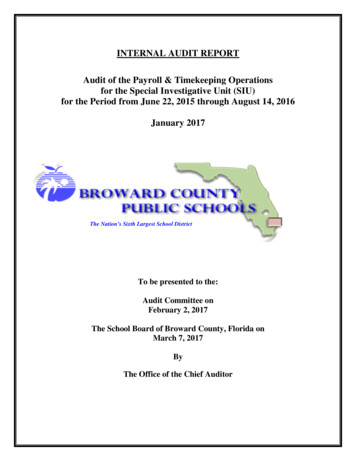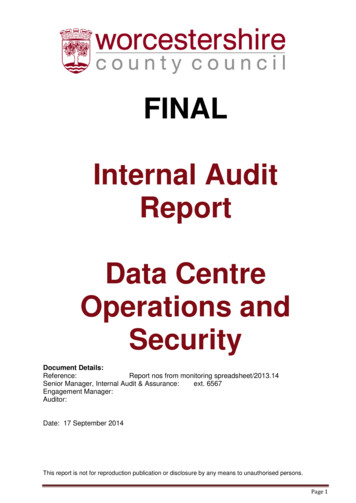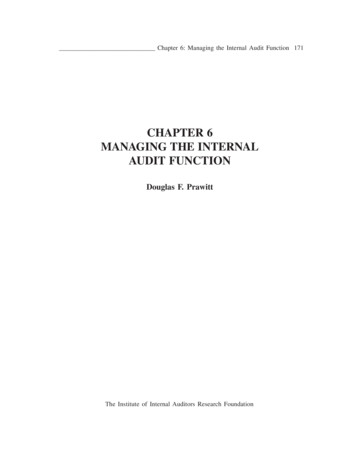
Transcription
What does Agile Internal Auditlook like in real life?A combination of examples on how Internal Audit leaders haveenhanced effectiveness and efficiency with an Agile approach.The Institute of Internal Auditors – Edmonton ChapterPresented by:Richard ArthursPartner, Enterprise Risk ServicesAllen AmyotteDirector of Internal AuditUniversity of AlbertaSept. 17, 2020
2
3
What is Agile Internal Audit?Little A versus Big A
Agile – why are we hearing so much about it?
What is “Agile Internal Auditing”?Little A vs Big A
The Historic Waterfall Approach to Internal Audit
Big A - Agile ManifestoWhile there is value in the items on the right, we value the items on the left more.Individuals and interactionsoverProcess and proceduresWorking softwareoverComprehensive documentationCustomer collaborationResponding to changeoveroverContract negotiationFollowing a planSource: www.agilemanifesto.orgAgile Manifesto for Software Development. (2017, June 27). Retrieved November 09, 2017, from anifesto/
Making the Shift to Agile (Small a)FROM Perfect communicationRigidly planned activitiesComprehensive documentationEstablished rolesFollowing a preset planAuditing to Internal Audit resourcesControl of the audit processTO Frequent communicationQuick, iterative activitiesTimely, relevant documentation and reportingEmpowered roles and flexible systemResponding to emerging needsTransparency in the process
Applying Small a to the Internal Audit Process Risk AssessmentAnnual planningEngagement planningOngoing communication with team, client, and Audit CommitteeEngagement executionIntegration with subject matter expertsUse of analyticsReporting and follow-upCulture and Change ManagementLearning and Development
Real Life Examples:
Google –Small a
University of Alberta – Small a
General Mills – Big A
University of Calgary – Small a
Government of CanadaProject Phoenix (Where was Agile?)
Big A – Agile Methodology
Agile Audit PhasesScrumASM: Audit Scrum MasterDoR: Definition of ReadyAST: Audit Scrum TeamSME: Subject Matter ExpertDoD: Definition of DoneKBO: Key Business OwnerPO: Product Owner
What is Scrum? (The Retrospective
Why consider using Agile/Scrum methods?“Agile-Scrum reduce audit risk”Flexibility reduces business-environment related riskRegular feedback reduces expectations-related riskTeam ownership reduces estimation riskTransparency reduces non-detection riskIterative delivery reduces investment risk
Small a – Agile Internal Audit
Agile Internal AuditingA.B.C.D.Risk assessment and audit planAudit planning and scopingExecute audit – fieldworkDeliver insights – reporting
A. Risk Assessment & Audit Plan Stage Clarify & Gain Alignment on Value PropositionElevate the use of data analyticsContinuous risk assessment vs. annual – more periodic touchpointsSurvey versus interview basedDevelop audit plan to include more areas to be covered in the year% of audit plan left as TBD based on dynamic risk assessment
B. Audit Planning and Scoping Clarify & Gain Alignment on Value PropositionIdentify select scope areas vs. full scope auditsUse of analyticsAudit cycle target 1-3 week sprintsNon-traditional audit team composition
C. Execute Audit - Fieldwork Analytics to eliminate sample testing Revisit documentation needs based onassurance vs. advisory projects Innovate the review process – more real timereviews
D. Deliver Insights - Reporting Disrupt reporting process – insight driven releases Identify point of acceptance Consider alternate methods of reporting – report on trends vs endof project Incorporate reporting into the sprints – insights delivered realtime with acceptance
3 Steps to Start Becoming More Agile1)Think strategically about your ideal state2)Remain relevant by transforming and disrupting your Internal Audit function3)Build preparedness and adaptability into your Internal Audit function DNAPwC. (2017). 2017 State of the Internal Audit Profession Study.
Questions ?RICHARD ARTHURSPartner- Enterprise Risk ServicesNational Leader – Internal Audit ServicesRichard.Arthurs@mnp.ca587.583.9155Allen AmyotteDirector of Internal Audit
Thank You!May 21, 2020
Why consider using Agile/Scrum methods? “Agile-Scrum reduce audit risk” Regular feedback reduces expectations-related risk Team ownership reduces estimation risk Transparency reduces non-detection risk Iterative delivery reduces investment risk Flexibility reduces business-environment related risk











